Southern Carpathian Periglaciation in Transition: The Role of Ground Thermal Regimes in a Warming Climate
Abstract
1. Introduction
2. Materials and Methods
2.1. Study Area
2.2. Methodology
2.2.1. Instrumentation
2.2.2. Parameters
3. Results
3.1. Long-Term Air Temperature
3.2. Thermal Regimes
3.3. Periglacial Conditions
4. Discussion
5. Conclusions
Author Contributions
Funding
Data Availability Statement
Acknowledgments
Conflicts of Interest
References
- French, H.M. The Periglacial Environment, 3rd ed.; Wiley: Chichester, UK, 2007; 458p. [Google Scholar]
- Harris, S.A.; French, H.M.; Heginbottom, J.A.; Johnston, G.H.; Ladanyi, B.; Sego, D.C.; van Everdingen, R.O. Glossary of Permafrost and Related Ground-Ice Terms; National Research Council of Canada: Ottawa, ON, Canada, 1988; 156p. [Google Scholar]
- Oliva, M.; Fernández-Fernández, J.M.; Nývlt, D. The Periglaciation of Europe. In Periglacial Landscapes of Europe; Oliva, M., Nývlt, D., Fernández-Fernández, J.M., Eds.; Springer: Cham, Germany, 2022. [Google Scholar] [CrossRef]
- Washburn, A.L. Geocryology: A Survey of Periglacial Processes and Environments; Edward Arnold: London, UK, 1979; 406p. [Google Scholar]
- Yang, B.; Duan, Y.; Zhao, J.; Tan, C.; Gesang, J.; Chen, L.; Zhao, Y.; Zhang, X. Response of soil hydrothermal processes within the active layer to variable alpine vegetation in the Yangtze River Source Area, Qinghai-Tibet Plateau. J. Hydrol. Reg. Stud. 2024, 54, 101850. [Google Scholar] [CrossRef]
- Guo, H.-X.; Zhu, W.-Q.; Xiao, C.-D.; Zhao, C.-L.; Chen, L.-Y. The freezing-thawing index and permafrost extent in pan-Arctic experience rapid changes following the global warming hiatus. Adv. Clim. Change Res. 2025, 16, 350–360. [Google Scholar] [CrossRef]
- Ferreira, A.; Vieira, G.; Ramos, M.; Nieuwendam, A. Ground temperature and permafrost distribution in Hurd Peninsula (Livingston Island, Maritime Antarctic): An assessment using freezing indexes and TTOP modelling. Catena 2017, 149, 560–571. [Google Scholar] [CrossRef]
- Pisabarro, A.; Pellitero, R.; Serrano, E.; Gómez-Lende, M.; González-Trueba, J.J. Ground temperatures, landforms and processes in an Atlantic Mountain: Cantabrian Mountains (Northern Spain). Catena 2017, 149, 623–636. [Google Scholar] [CrossRef]
- Baptista, J.; Vieira, G.; Lee, H. Ground surface temperature regimes are controlled by the topography and snow cover in the ice-free areas of Maritime Antarctica. Catena 2024, 240, 107947. [Google Scholar] [CrossRef]
- Biskaborn, B.K.; Smith, S.L.; Noetzli, J.; Matthes, H.; Vieira, G.; Streletskiy, D.A.; Schoeneich, P.; Romanovsky, V.E.; Lewkowicz, A.G.; Abramov, A.; et al. Permafrost is warming at a global scale. Nat. Commun. 2019, 10, 264. [Google Scholar] [CrossRef] [PubMed]
- GTN-P. Global Terrestrial Network for Permafrost Metadata for Active Layer Monitoring (CALM) Sites [Dataset]; PANGAEA: Bremen, Germany, 2015. [Google Scholar] [CrossRef]
- PERMOS. Swiss Permafrost Bulletin 2024; Noetzli, J., Pellet, C., Eds.; PERMOS: Zürich, Switzerland, 2025; Volume 6, 29p. [Google Scholar]
- Onaca, A.; Urdea, P.; Ardelean, A.C.; Șerban, R.; Ardelean, F. Present-day periglacial processes in the alpine zone. In Landform Dynamics and Evolution in Romania; Rădoane, M., Vespremeanu-Stroe, A., Eds.; Springer Geography: Cham, Germany, 2017; pp. 147–176. [Google Scholar]
- Onaca, A. Procese și Forme Periglaciare din Carpații Meridionali. Abordare Geomorfologică și Geofizică/Periglacial Processes and Landforms from the Southern Carpathians: A Geomorphological and Geophysical Approach; Editura Universității de Vest din Timișoara: Timișoara, Romania, 2017; 264p. [Google Scholar]
- Popescu, R.; Filhol, S.; Etzelmüller, B.; Vasile, M.; Pleșoianu, A.; Vîrghileanu, M.; Onaca, A.; Șandric, I.; Săvulescu, I.; Cruceru, N.; et al. Permafrost distribution in the Southern Carpathians, Romania, derived from machine learning modeling. Permafr. Periglac. 2024, 35, 243–261. [Google Scholar] [CrossRef]
- Vasile, M.; Vespremeanu-Stroe, A.; Popescu, R. Air versus ground temperature data in the evaluation of frost weathering and ground freezing: Examples from the Romanian Carpathians. Rev. Geomorfol. 2014, 16, 61–70. [Google Scholar]
- IPCC. Climate Change 2021: The Physical Science Basis. In Contribution of Working Group I to the Sixth Assessment Report of the Intergovernmental Panel on Climate Change *; Masson-Delmotte, V., Zhai, P., Pirani, A., Connors, S.L., Chen, Y., Goldfarb, L., Gomis, M.I., Matthews, J.B.R., Berger, S., Huang, M., et al., Eds.; IPCC: Geneva, Switzerland, 2021; Available online: https://www.ipcc.ch/report/ar6/wg1/downloads/report/IPCC_AR6_WGI_SummaryVolume.pdf (accessed on 10 March 2025).
- Niculescu, G. Relieful glaciar din Munții Țarcu. Stud. Cercet. Geogr. 1990, 37, 43–52. [Google Scholar]
- Urdea, P.; Ardelean, F.; Ardelean, M.; Onaca, A. Chapter 14—Glacial landscapes of the Romanian Carpathians. In European Glacial Landscapes: Maximum Extent of Glaciations; Palacios, D., Hughes, P.D., Garcia-Ruiz, J.M., de Andres, N., Eds.; Elsevier: Amsterdam, The Netherlands, 2022; pp. 109–114. [Google Scholar]
- Kuhlemann, J.; Dobre, F.; Urdea, P.; Krumrei, I.; Gachev, E.; Kubik, P.; Rahn, M. Last glacial maximum glaciation of the central South Carpathian Range (Romania). Aust. J. Earth Sci. 2013, 106, 83–95. [Google Scholar]
- Ruszkiczay-Rüdiger, Z.; Kern, Z.; Urdea, P.; Braucher, R.; Madarasz, B.; Schimmelpfennig, I. Revised deglaciation history of the Pietrele–Stânișoara glacial complex, Retezat Mts, Southern Carpathians, Romania. Quat. Int. 2016, 415, 216–229. [Google Scholar] [CrossRef]
- Ruszkiczay-Rüdiger, Z.; Kern, Z.; Urdea, P.; Madarasz, B.; Braucher, R. Limited glacial erosion during the last glaciation in mid-latitude cirques (Retezat Mts, Southern Carpathians, Romania). Geomorphology 2021, 384, 107719. [Google Scholar] [CrossRef]
- Kern, Z.; Urdea, P.; Ardelean, M.; ASTER Team; Ruszkiczay-Rüdiger, Z. Updated chronology of the last deglaciation in the Făgăraș Mts. (Romania). Geosciences 2025, 15, 109. [Google Scholar] [CrossRef]
- Haberkorn, A.; Hoelzle, M.; Phillips, M.; Kenner, R. Snow as a driving factor of rock surface temperatures in steep rough rock walls. Cold Reg. Sci. Technol. 2015, 118, 64–75. [Google Scholar] [CrossRef]
- Delaloye, R. Contribution à L’étude du Pergélisol de Montagne en Zone Marginale. Ph.D. Thesis, University of Fribourg, Fribourg, Switzerland, 2004; 244p. [Google Scholar]
- Ribolini, A.; Fabre, D. Permafrost existence in rock glaciers of the Argentera Massif, Maritime Alps, Italy. Permafr. Periglac. Process. 2006, 17, 49–63. [Google Scholar] [CrossRef]
- Hales, T.C.; Roering, J.J. Climatic controls on frost cracking and implications for the evolution of bedrock landscapes. J. Geophys. Res. 2007, 112, F02033. [Google Scholar] [CrossRef]
- Schoeneich, P. Guide Lines for Monitoring GST—Ground Surface Temperature, Permanent Project. Version 3. 2 February 2011. Available online: https://www.permanet-alpinespace.eu/archive/pdf/GST.pdf (accessed on 20 April 2025).
- Haeberli, W. Die Basis-Temperatur der winterlichen Schneedecke als möglicher Indikator für die Verbreitung von Permafrost in den Alpen. Z. Gletscherkd. Glazialgeol. 1973, 9, 221–227. [Google Scholar]
- Hoelzle, M.; Mittaz, C.; Etzelmüller, B.; Haeberli, W. Surface energy fluxes and distribution models of permafrost in European mountain areas: An overview of current developments. Permafr. Periglac. Process. 2001, 12, 53–68. [Google Scholar] [CrossRef]
- Outcalt, S.I.; Nelson, F.E.; Hinkel, K.M. The zero-curtain effect: Heat and mass transfer across an isothermal region in freezing soil. Water Resour. Res. 1990, 26, 1509–1516. [Google Scholar] [CrossRef]
- Staub, B.; Hasler, A.; Noetzli, J.; Delaloye, R. Gap-filling algorithm for ground surface temperature data measured in permafrost and periglacial environments. Permafr. Periglac. Process. 2016, 28, 275–285. [Google Scholar] [CrossRef]
- Nelson, F.E.; Outcalt, S.I. A computational method for prediction and regionalization of permafrost. Arct. Alp. Res. 1987, 19, 279–288. [Google Scholar] [CrossRef]
- Smith, M.W.; Riseborough, D.W. Climate and the limits of permafrost: A zonal analysis. Permafr. Periglac. Process. 2002, 13, 1–15. [Google Scholar] [CrossRef]
- Bai, J.; Perron, P. Computation and Analysis of Multiple Structural Change Models. J. Appl. Econom. 2003, 18, 1–22. [Google Scholar] [CrossRef]
- Schwarz, G. Estimating the Dimension of a Model. Ann. Stat. 1978, 6, 461–464. [Google Scholar] [CrossRef]
- Allen, M.R.; Dube, O.P.; Solecki, W.; Aragón-Durand, F.; Cramer, W.; Humphreys, S.; Kainuma, M.; Kala, J.; Mahowald, N.; Mulugetta, Y.; et al. Framing and Context. In Global Warming of 1.5 °C; An IPCC Special Report on the Impacts of Global Warming of 1.5 °C Above Pre-Industrial Levels and Related Global Greenhouse Gas Emission Pathways, in the Context of Strengthening the Global Response to the Threat of Climate Change; Masson-Delmotte, V., Zhai, P., Pörtner, H.-O., Roberts, D., Skea, J., Shukla, P.R., Pirani, A., Moufouma-Okia, W., Péan, C., Pidcock, R., et al., Eds.; Cambridge University Press: Cambridge, UK; New York, NY, USA, 2018; pp. 49–92. [Google Scholar] [CrossRef]
- Harris, S.A.; Pedersen, D.E. Thermal regimes beneath coarse blocky materials. Permafr. Periglac. Process. 1998, 3, 107–120. [Google Scholar] [CrossRef]
- Kneisel, C.; Hauck, C.; Vonder Mühll, D. Permafrost below the timberline confirmed and characterized by geoelectrical resistivity measurements, Bever Valley, eastern Swiss Alps. Permafr. Periglac. Process. 2000, 11, 295–304. [Google Scholar] [CrossRef]
- Sawada, Y.; Ishikawa, M.; Ono, Y. Thermal regime of sporadic permafrost in a block slope on Mt. Ni-shi-Nupukaushinupuri, Hokkaido Island, Northern Japan. Geomorphology 2003, 52, 121–130. [Google Scholar] [CrossRef]
- Juliussen, H.; Humlum, O. Thermal regime of openwork block fields on the mountains Elgåhogna and Sølen, central-eastern Norway. Permafr. Periglac. Process. 2008, 19, 1–18. [Google Scholar] [CrossRef]
- Colucci, R.R.; Forte, E.; Žebre, M.; Maset, E.; Zanettini, C.; Guglielmin, M. Is that a relict rock glacier? Geomorphology 2019, 330, 177–189. [Google Scholar] [CrossRef]
- Delaloye, R.; Lambiel, C. Evidence of winter ascending air circulation throughout talus slopes and rock glaciers situated in the lower belt of alpine discontinuous permafrost (Swiss Alps). Nor. Geogr. Tidsskr. 2005, 59, 194–203. [Google Scholar] [CrossRef]
- Wicky, J.; Hilbich, C.; Delaloye, R.; Hauck, C. Modeling the link between air convection and the occurrence of short-term permafrost in a low-altitude cold talus slope. Permafr. Periglac. Process. 2024, 35, 202–217. [Google Scholar] [CrossRef]
- Kellerer-Pirklbauer, A. Potential weathering by freeze–thaw action in alpine rocks in the European Alps during a nine-year monitoring period. Geomorphology 2017, 296, 113–131. [Google Scholar] [CrossRef]
- Zhang, T. Influence of the seasonal snow cover on the ground thermal regime: An overview. Rev. Geophys. 2005, 43, RG4002. [Google Scholar] [CrossRef]
- Gruber, S.; Haeberli, W. Permafrost in steep bedrock slopes and its temperature-related destabilization following climate change. J. Geophys. Res. 2007, 112, F02S18. [Google Scholar] [CrossRef]
- Zhirkov, A.; Permyakov, P.; Wen, Z.; Kirillin, A. Influence of rainfall changes on the temperature regime of permafrost in Central Yakutia. Land 2021, 10, 1230. [Google Scholar] [CrossRef]
- Saas, O. Rock moisture measurements: Techniques, results and implications for weathering. Earth Surf. Process. Landf. 2005, 30, 359–374. [Google Scholar] [CrossRef]
- Matsuoka, N. Frost weathering and rockwall erosion in the southeastern Swiss Alps: Long-term (1994–2008) observations. Geomorphology 2008, 99, 353–368. [Google Scholar] [CrossRef]
- Șerban, R. Studiu Asupra Solifluxiunii Din Zona Alpină a Carpaților Meridionali/Study on the Solifluction of the Southern Carpathians Alpine Zone; Editura Universității de Vest din Timișoara: Timișoara, Romania, 2021; 280p. [Google Scholar]
- Onaca, A.; Magori, B.; Urdea, P.; Chiroiu, P. Near surface thermal characteristics of alpine steep rockwalls in the Retezat Mountains. Forum Geogr. 2015, 14, 124–133. [Google Scholar] [CrossRef]
- Ikeda, A. Combination of conventional geophysical methods for sounding the composition of rock glaciers in the Swiss Alps. Permafr. Periglac. Process. 2006, 17, 35–48. [Google Scholar] [CrossRef]
- Isaksen, K.; Ødegård, R.S.; Etzelmüller, B.; Hilbich, C.; Hauck, C.; Farbrot, H.; Eiken, T.; Hygen, H.O.; Hipp, T.F. Degradingmountain permafrost in southern Norway: Spatial and temporal variability of mean ground temperatures, 1999–2009. Permafr. Periglac. Process. 2011, 22, 361–377. [Google Scholar] [CrossRef]
- Vieira, G.; Mora, C.; Faleh, A. New observations indicate the possible presence of permafrost in North Africa (Djebel Toubkal, High Atlas, Morocco). Cryosphere 2017, 11, 1691–1705. [Google Scholar] [CrossRef]
- Noetzli, J.; Isaksen, K.; Barnett, J.; Christiansen, H.H.; Delaloye, R.; Etzelmüller, B.; Farinotti, D.; Gallemann, T.; Guglielmin, M.; Hauck, C.; et al. Enhanced warming of European mountain permafrost in the early 21st century. Nat. Commun. 2024, 15, 10508. [Google Scholar] [CrossRef] [PubMed]
- Aalto, J.; Harrison, S.; Luoto, M. Statistical modelling predicts almost complete loss of major periglacial processes in Northern Europe by 2100. Nat. Commun. 2017, 8, 515. [Google Scholar] [CrossRef] [PubMed]
- Haeberli, W.; Gruber, S. Global warming and mountain permafrost. In Permafrost Soils; Margesin, R., Ed.; Springer: Berlin/Heidelberg, Germany, 2009; pp. 205–218. [Google Scholar] [CrossRef]
- Brighenti, S.; Hotaling, S.; Finn, D.S.; Fountain, A.G.; Hayashi, M.; Herbst, D.; Saros, J.E.; Tronstad, L.M.; Millar, C.I. Rock glaciers and related cold rocky landforms: Overlooked climate refugia for mountain biodiversity. Glob. Change Biol. 2021, 27, 1504–1517. [Google Scholar] [CrossRef] [PubMed]
- Hotaling, S.; Foley, M.E.; Zeglin, L.H.; Finn, D.S.; Tronstad, L.M.; Giersch, J.J.; Muhlfeld, C.C.; Weisrock, D.W. Microbial assemblages reflect environmental heterogeneity in alpine streams. Glob. Change Biol. 2019, 25, 2576–2590. [Google Scholar] [CrossRef]
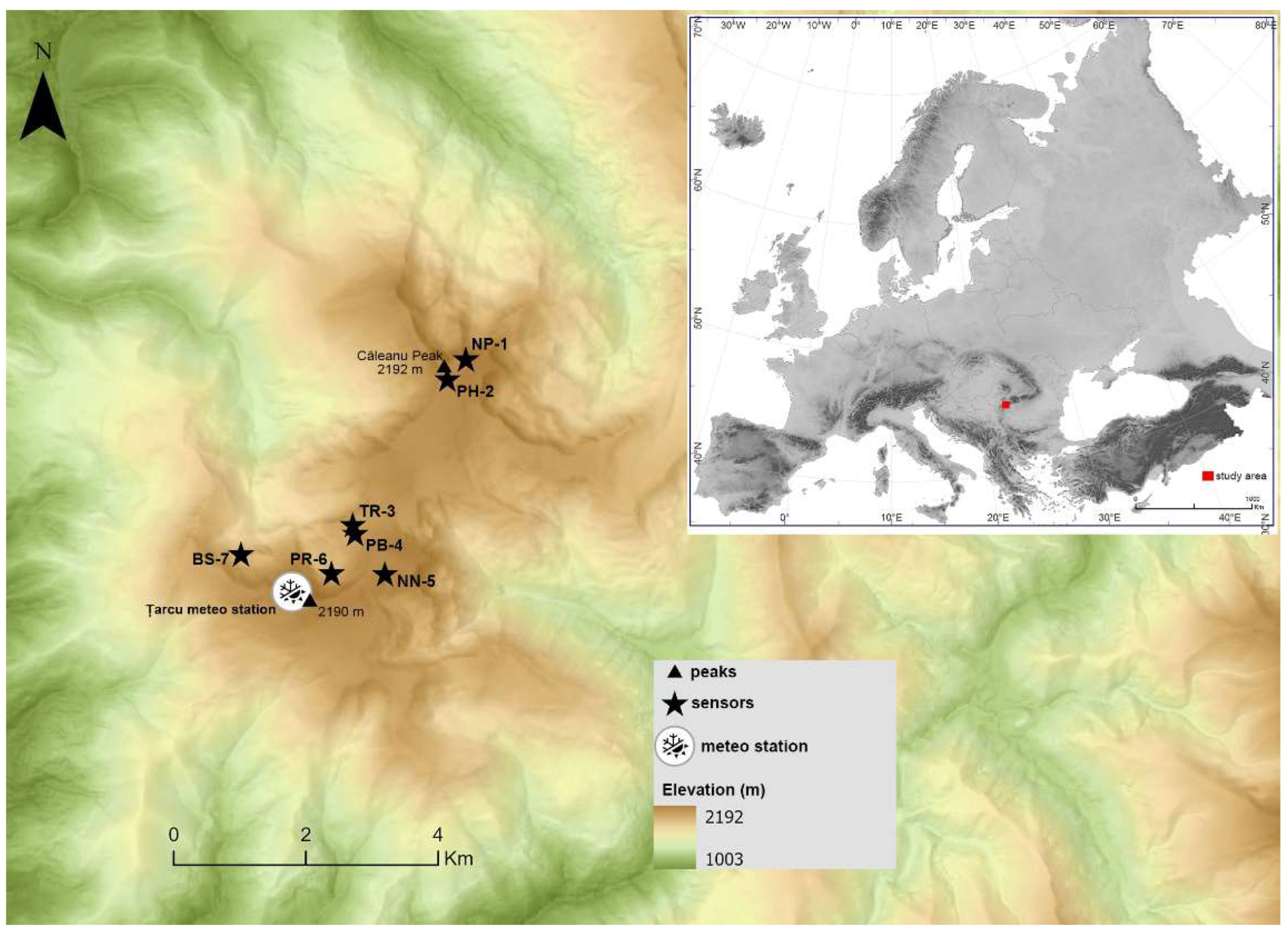


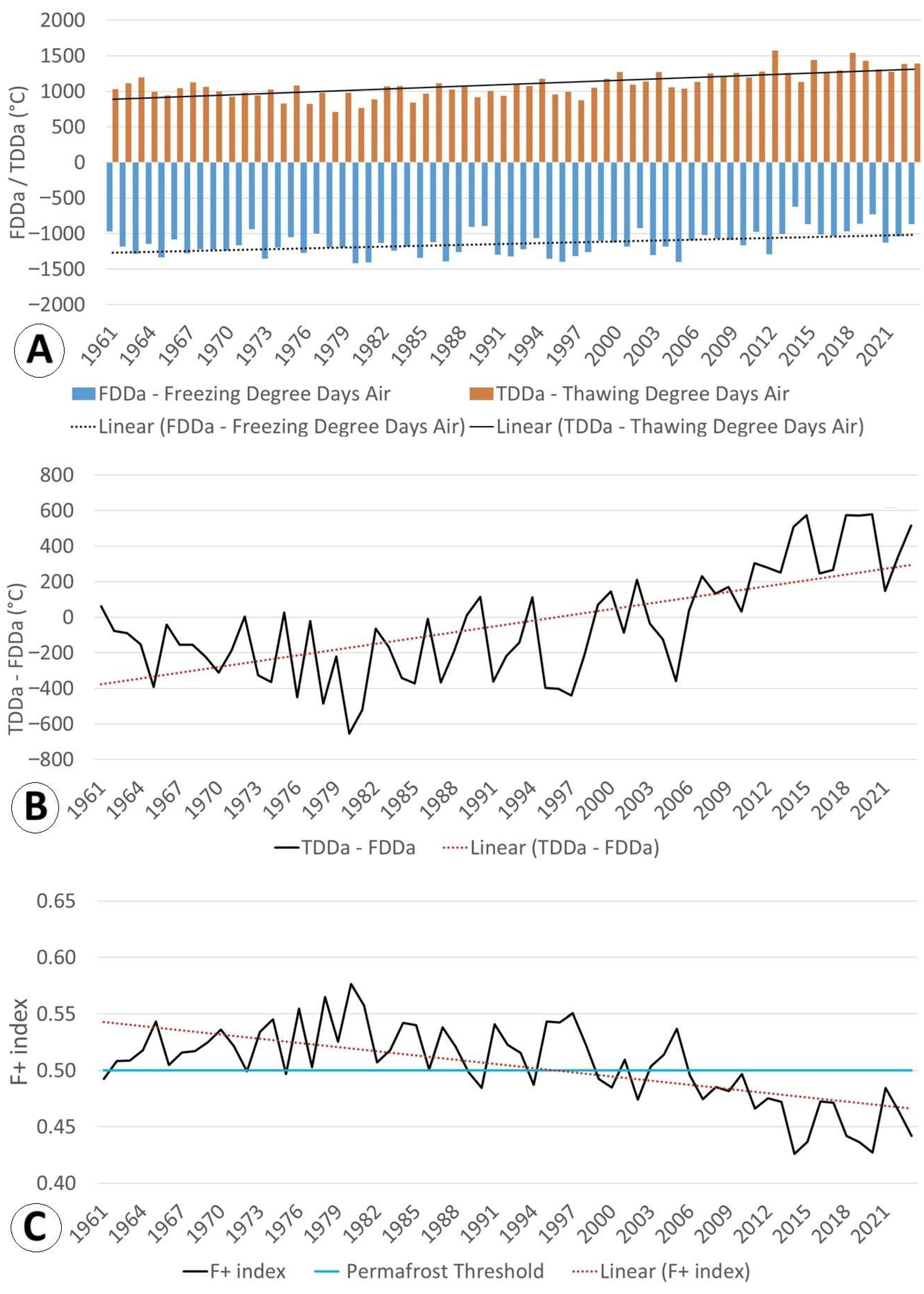
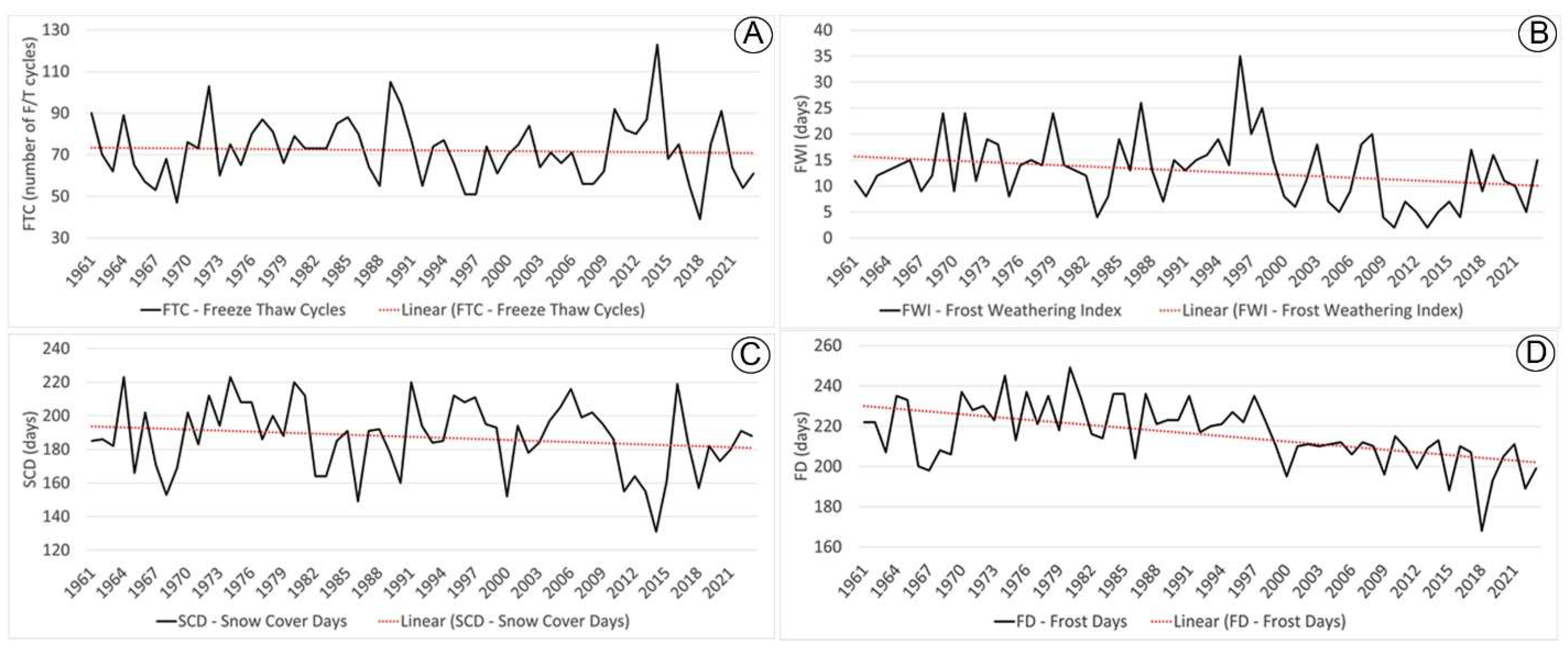
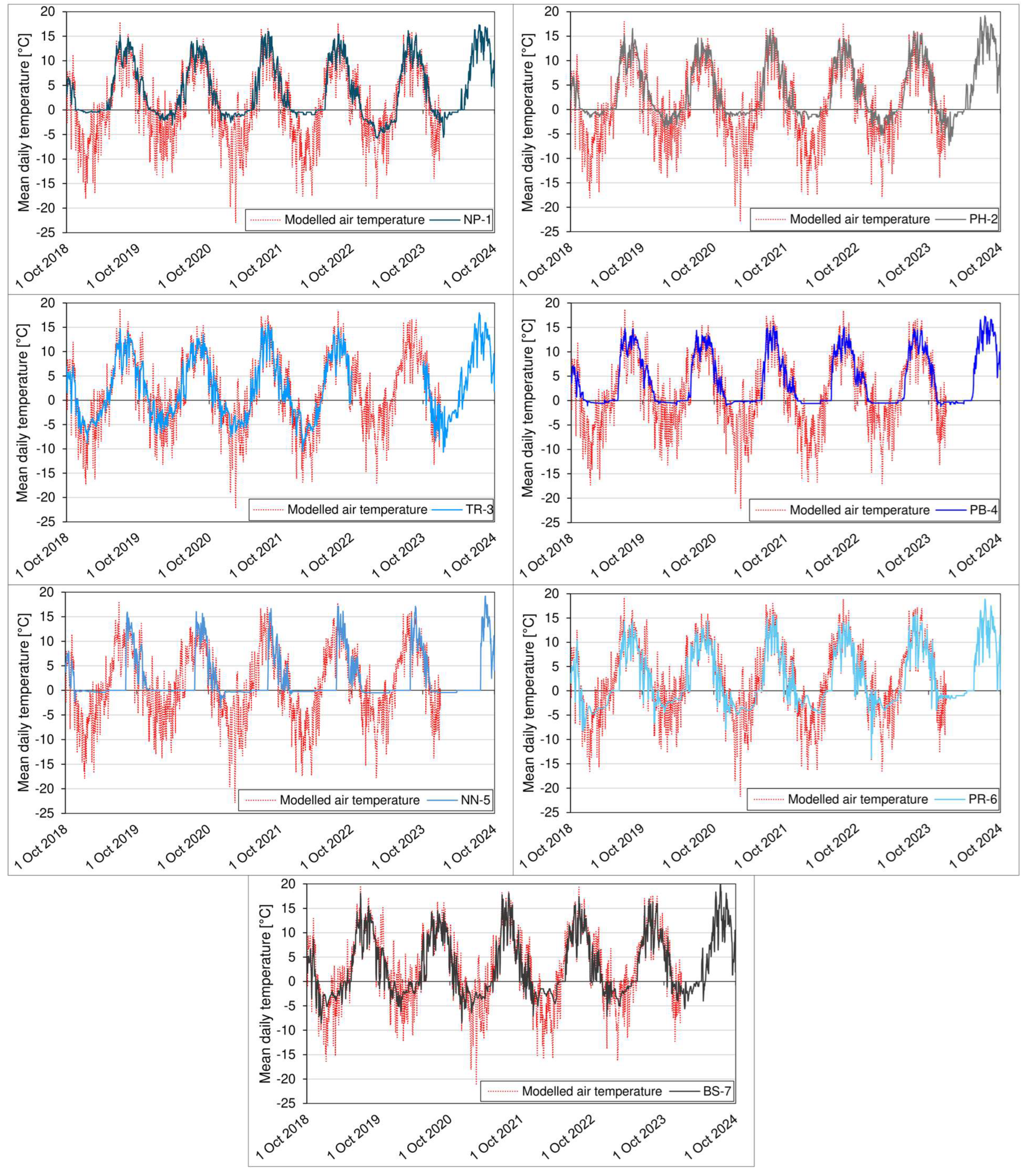

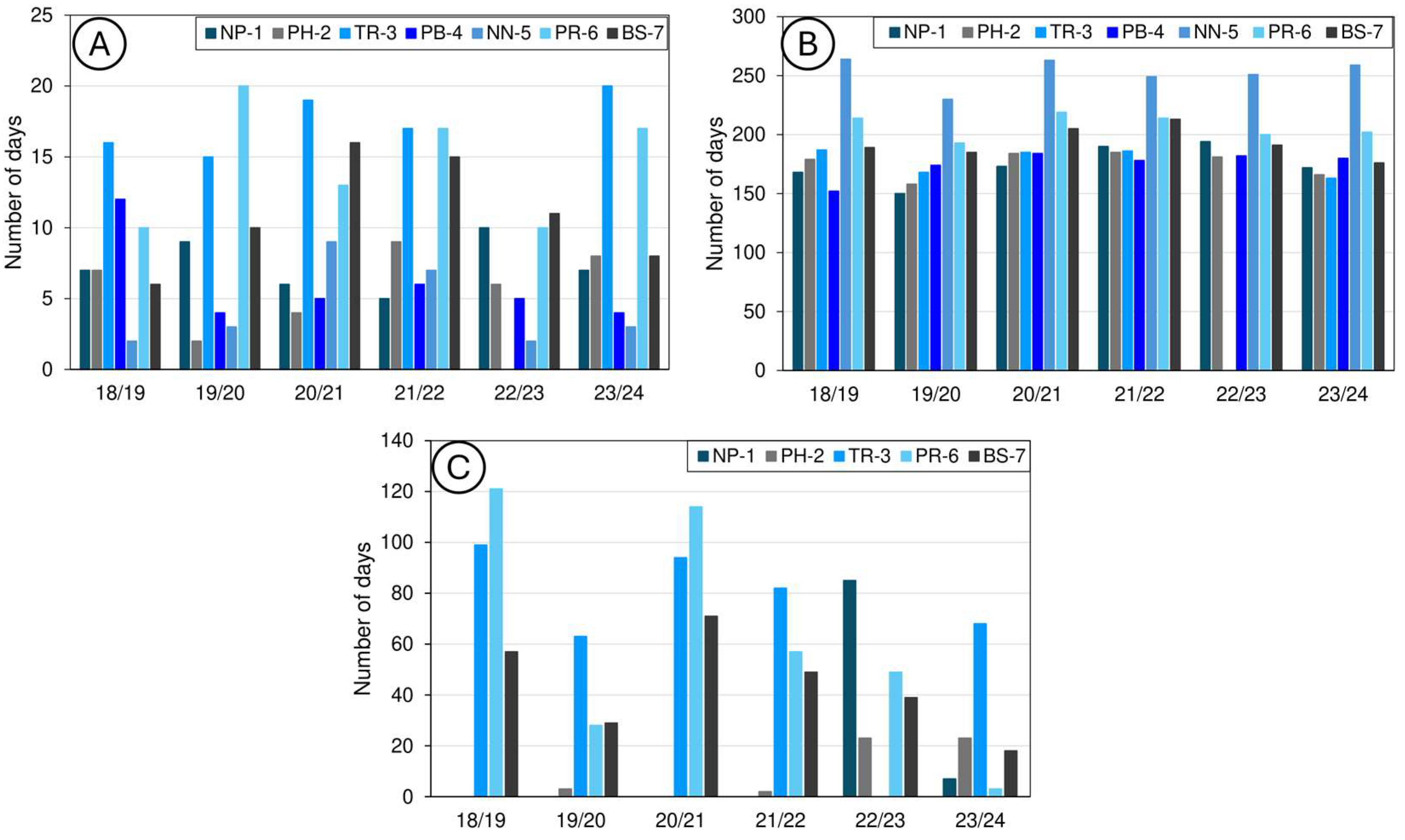


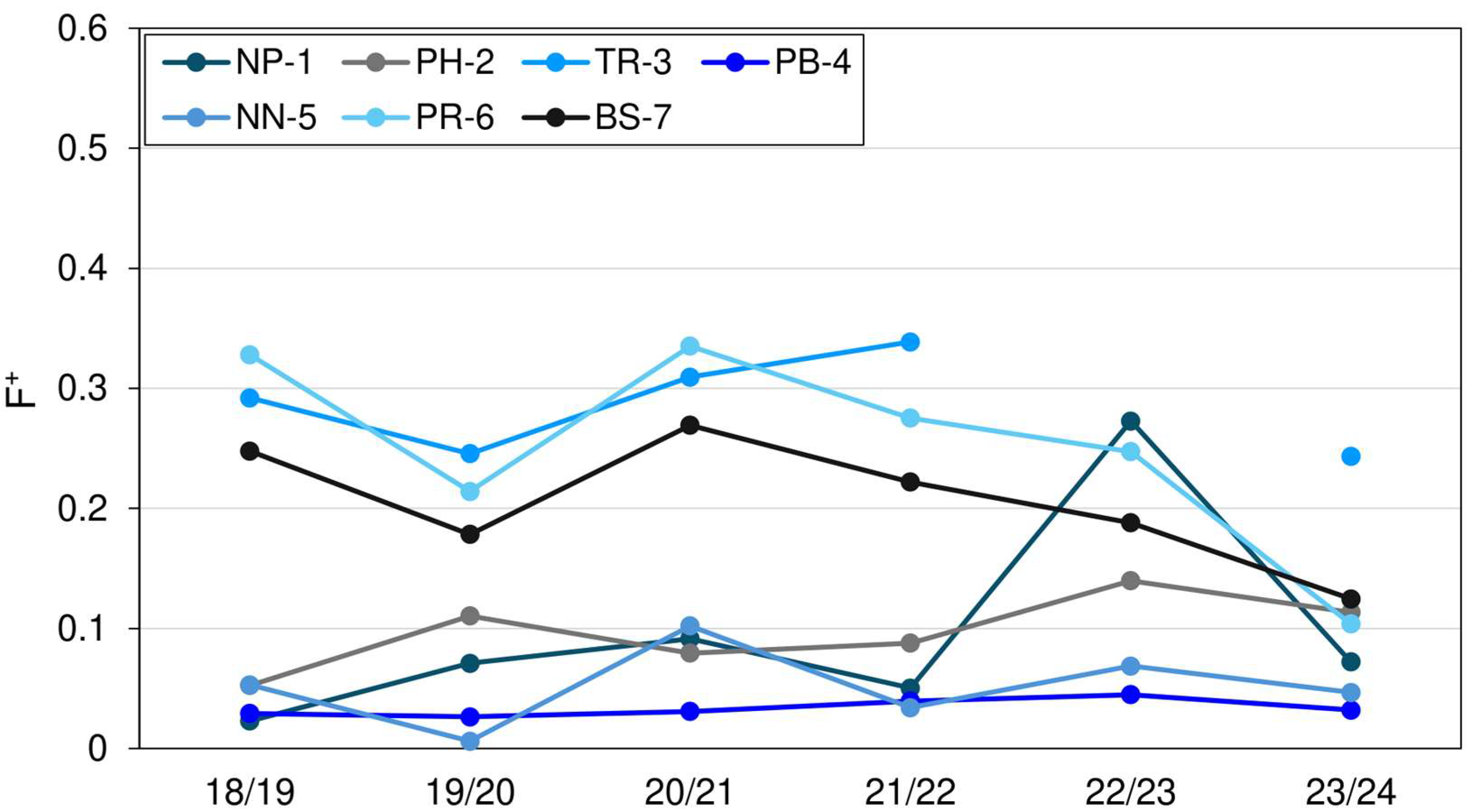
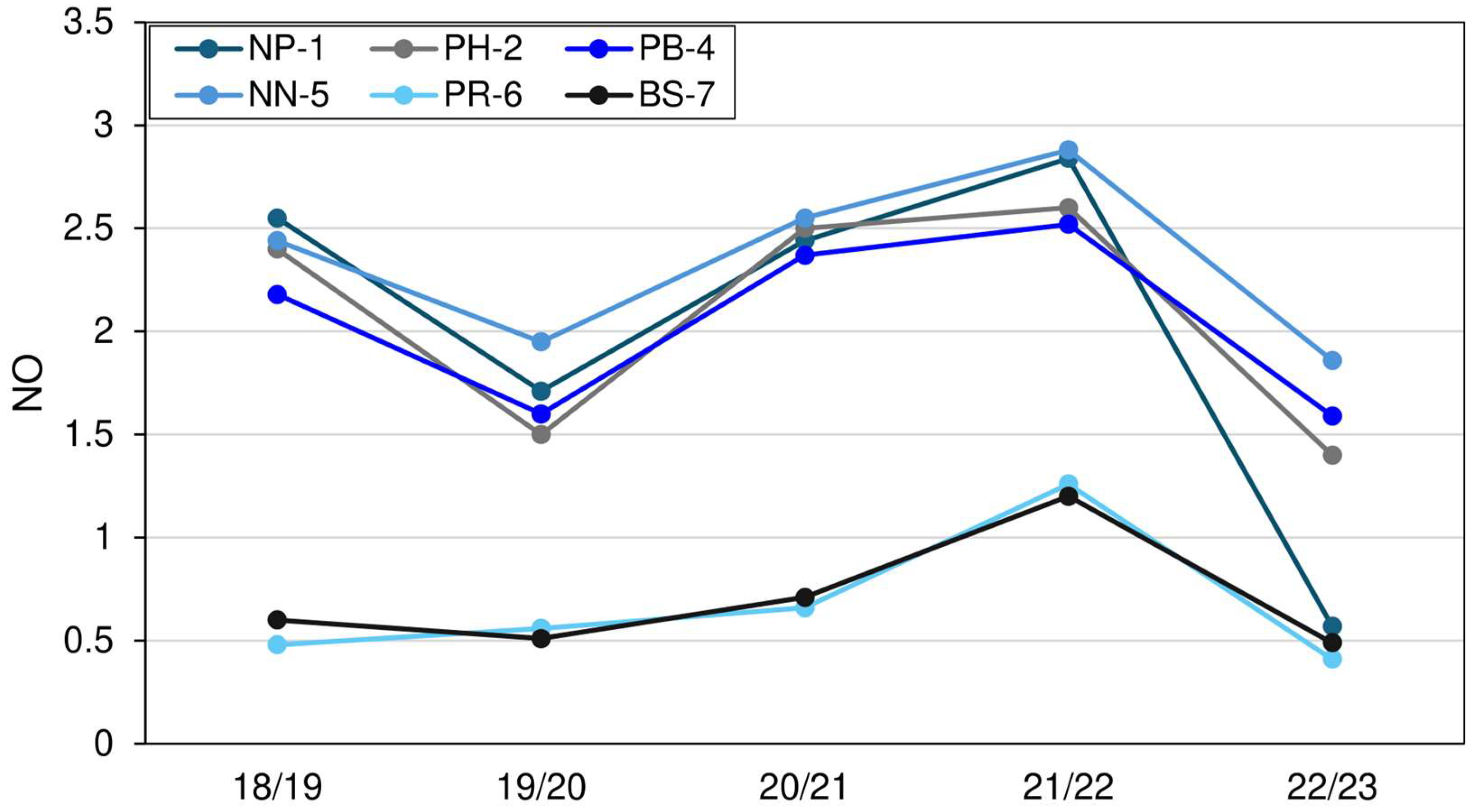
| Site | Morphology | Elevation (m) | Slope (°) | Substrate | Data Series |
|---|---|---|---|---|---|
| NP-1 | Non-sorted polygons | 2176 | 9 | Fine-grained deposits | 1 October 2018–30 September 2024 |
| PH-2 | Periglacial hummocks | 2170 | 5 | Fine-grained deposits | 1 October 2018–30 September 2024 |
| TR-3 | Periglacial tor | 2059 | 78 | Rockwall | 1 October 2018–30 September 2024 * |
| PB-4 | Ploughing boulder | 2053 | 13 | Fine-grained deposits | 1 October 2018–30 September.2024 |
| NN-5 | Nival niche | 2147 | 11 | Fine-grained deposits | 1 October 2018–30 September 2024 |
| PR-6 | Protalus rampart | 1975 | 14 | Coarse debris | 1 October 2018–30 September 2024 |
| BS-7 | Block stream | 1904 | 18 | Coarse debris | 1 October 2018–30 September 2024 |
| Parameter (Code) | Description | Unit | Timescales |
|---|---|---|---|
| MAGST | Mean annual ground surface temperature | °C | HY |
| MAAT | Mean annual air temperature | °C | CY and HY |
| FDDa | Freezing degree days sums for air temperature | °C days | CY |
| TDDa | Thawing degree days sums for air temperature | °C days | CY |
| FDDg | Freezing degree days sums for ground temperature | °C days | HY |
| TDDg | Thawing degree days sums for ground temperature | °C days | HY |
| FTC | Days with diurnal freeze–thaw cycles | Number of days | CY and HY |
| FD | Frost days | Number of days | CY and HY |
| FWI | Frost weathering interval | Number of days | CY and HY |
| WEqT | Winter equilibrium temperature | °C | HY |
| ZCP | Zero curtain period | Number of days | HY |
| SCD | Snow cover duration | Number of days | CY and HY |
| F+ | Dimensionless index—estimate permafrost | CY | |
| NO | Dimensionless index—estimate snow thermal insulation | HY |
| Parameter | Slope | R2 | p-Value | Stdev |
|---|---|---|---|---|
| MAAT (1961–2023) | 0.03 | 0.43 | <0.001 | 0.83 |
| MAAT (1961–1981) | −0.50 | 0.32 | 0.007 | 0.02 |
| MAAT (1982–1994) | 0.35 | 0.07 | 0.351 | 0.04 |
| MAAT (1995–2023) | 0.81 | 0.67 | <0.001 | 0.01 |
| FDDa | −4.03 | 0.18 | 0.001 | 173.54 |
| TDDa | 6.83 | 0.48 | <0.001 | 180.48 |
| F+ | 0.00 | 0.43 | <0.001 | 15.02 |
| FTC | −0.04 | 0.00 | 0.695 | 6.51 |
| FWI | −0.09 | 0.06 | 0.044 | 20.73 |
| SCD | −0.21 | 0.03 | 0.153 | 15.23 |
| FD | −0.45 | 0.29 | <0.001 | 0.035 |
| Surface Type | Geomorphic Belts | Thermal Regime | Main Periglacial Processes | Main Active Landforms |
|---|---|---|---|---|
| Coarse debris | Isolated permafrost (2544–2000 m) | MAGST = −2–1.5 °C WEqT ≤ −2 °C FDDg = −450–−1500 °C days FD ≥ 200 days | Frost cracking Frost creep Permafrost creep Active layer processes Frost splitting | Rock glaciers Block streams Debris cones Debris lobes Debris talus Blockfields |
| No permafrost (2544–1650 m) | MAGST = 1.5–4 °C WEqT = −2.5–0 °C FDDg = 200–500 °C days FD = 150–250 days | Frost cracking Frost creep | Block streams Debris cones Debris talus | |
| Fine-grained sediments | Upper periglacial (2544–2100 m) | MAGST = 1–4 °C FTC = 5–50 cycles FDDg = 50–500 °C days FD = 150–225 days | Solifluction Cryoturbation Nivation Frost heaving Frost creep Frost sorting | Non-sorted polygons Sorted polygons Ploughing boulders Solifluction lobes Solifluction terraces Nivation hollows |
| Lower periglacial (2100–1650 m) | MAGST = 4–6 °C FTC = 1–20 cycles FDDg = 20–200 °C days FD = 100–150 days | Solifluction Nivation Frost heaving | Solifluction lobes Ploughing boulders Nivation hollows | |
| Rock walls | Upper periglacial (2544–2100 m) | MAGST = −1–+2.5 °C FTC = 15–140 cycles FDDg ≥ 500 °C days FD = 160–230 days | Frost cracking Rock falls | Summits Crest Rock Walls Periglacial tors |
| Lower periglacial (2100–1650 m) | MAGST = 2–5 °C FTC = 10–40 cycles FDDg ≤ 500 °C days FD = 115–190 days | Frost cracking | Periglacial tors Rock Walls |
Disclaimer/Publisher’s Note: The statements, opinions and data contained in all publications are solely those of the individual author(s) and contributor(s) and not of MDPI and/or the editor(s). MDPI and/or the editor(s) disclaim responsibility for any injury to people or property resulting from any ideas, methods, instructions or products referred to in the content. |
© 2025 by the authors. Licensee MDPI, Basel, Switzerland. This article is an open access article distributed under the terms and conditions of the Creative Commons Attribution (CC BY) license (https://creativecommons.org/licenses/by/4.0/).
Share and Cite
Ardelean, F.; Berzescu, O.; Chiroiu, P.; Ardelean, A.; Mălăieștean, R.; Onaca, A. Southern Carpathian Periglaciation in Transition: The Role of Ground Thermal Regimes in a Warming Climate. Land 2025, 14, 1756. https://doi.org/10.3390/land14091756
Ardelean F, Berzescu O, Chiroiu P, Ardelean A, Mălăieștean R, Onaca A. Southern Carpathian Periglaciation in Transition: The Role of Ground Thermal Regimes in a Warming Climate. Land. 2025; 14(9):1756. https://doi.org/10.3390/land14091756
Chicago/Turabian StyleArdelean, Florina, Oana Berzescu, Patrick Chiroiu, Adrian Ardelean, Romolus Mălăieștean, and Alexandru Onaca. 2025. "Southern Carpathian Periglaciation in Transition: The Role of Ground Thermal Regimes in a Warming Climate" Land 14, no. 9: 1756. https://doi.org/10.3390/land14091756
APA StyleArdelean, F., Berzescu, O., Chiroiu, P., Ardelean, A., Mălăieștean, R., & Onaca, A. (2025). Southern Carpathian Periglaciation in Transition: The Role of Ground Thermal Regimes in a Warming Climate. Land, 14(9), 1756. https://doi.org/10.3390/land14091756







